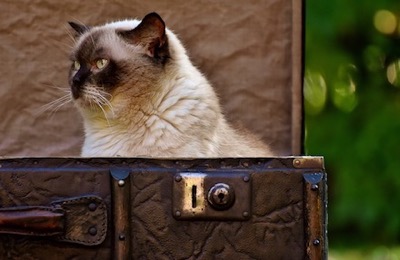Finding Lost Animals - Part 4
February 24, 2018 Filed in:
Finding Lost AnimalsHow Do Animal Communicators Find Lost Animals?
What skills are required? Are missing animals always lost or do they leave for other reasons?
We’ll answer these questions in this section of Brenda Fullick’s interview of animal communicators and other research.
Tracking
Working with lost animals is hard. But it can also be thrilling.
“I love these. These are so much fun,” Jacquelin Smith says. “There’s always divine beings helping and working. I just consider myself the conduit, [with the divine] working through me.” In one case, Jacquelin felt a missing cat was trapped inside a rundown old house. The caller suddenly remembered he had a key to that house because he had done work there many years before. The cat turned out to be inside. “To me,” Jacquelin says, “that’s divine intervention.”
Jacquelin’s primary technique is to look through the animals’ eyes. “I track step by step from the time they left,” she says. “We always track them to where they are in the moment — knowing that in the next moment they can be running down the street.” Jacquelin pays attention to compass directions while also noting local landmarks, like a red house with a chimney that she can see from the animal’s perspective. Meanwhile, she’s receiving supplemental information through clairvoyance or remote viewing. “I’m always working with directions,” she says. “To me, there’s a logical progression leading to where they are.”
But she can be misled. Such as in the case of a cat who disappeared from a company office. She followed this cat into a park. “I started tracking this cat, and all of a sudden I realized the cat was astrally traveling in the park,” Jacquelin says. She then saw the cat trapped in a dark place. Eventually, the company staff found him, still alive, trapped in a box in the warehouse.
Jacquelin typically asks clients to tell her as little as possible. She keeps them on the phone in case she needs clarification while she’s working, but she asks them to be quiet. “When I’m tracking, I make sure there’s absolutely no distraction around,” Jacquelin says. “You’re trying to get the clearest pictures possible. To me, it takes more concentration to do that work than anything else I do. It’s much more challenging — especially if the animal’s on the move.”
Leta Worthington, on the other hand, likes a give-and-take with the clients on the phone. She works with a sketchpad, often getting an aerial view of the scene and seeing landmarks that the clients will recognize. She asks clients which direction the house faces. “Sometimes I get a feeling for the direction they’ve gone in.”
Jim Worsley also likes dowsing with a pendulum or his fingers on a map to get a sense of directions. “It feels to me like there’s a circle. It expands until I feel the animal in it,” Jim says. “You might say I’m lassoing a vicinity.” Once he feels that he has the right area, he begins to ask questions. “I’m asking to see it through the animal’s eyes, so we see what they see.”
Annette Betcher dowses maps with her finger. “When it gets warm, that’s the place,” she says. “The tip of my finger will be warm, and it’ll kind of tingle.”
Tim Link also uses map dowsing. He first asks his client for the animal’s home address, the date the animal disappeared and the locations of any possible sightings.
After determining if the animal is still alive based on energy readings he receives, he then asks the animal a series of location-specific questions to gather as much detail as possible from the animal’s perspective.
Using a pendulum and a series of maps that match the addresses provided, he narrows down the location to where the animal’s energy signature is strongest and marks the map with locations that match the information that the animal shared.
Sit, Stay
Once communicators figure out where the animals seem to be, they face a new question: should they bring the animals to the clients, or should they bring the clients to the animals? If you try to pull the animal home with visualization, he may start moving again, which means the client can’t retrieve him from the location you’ve described.
The locations that the animals show you may not be current anyway, according to Whitney Taylor. “For instance, if they’re really hungry, they may beam pictures of the places they found food. It’s their way of saying, ‘Hey Mom, I’m not starving, because this is where I ate.’”
Finding locations can be especially difficult in the woods, Dawn Hayman says, “because a lot of things look the same in an area.” When the animals are wearing identification tags, sometimes it makes sense to encourage them to approach people, particularly mail carriers or police officers. Sometimes they can be convinced to use their own judgment and approach nice humans. When missing dogs are deep in the woods, Dawn sometimes can convince them to find a road and sit in a spot where they can be seen. But even the most gregarious animals may turn timid when they’re lost.
Stronger skills
Carol Gurney advises her students to ask themselves: could you find an animal with those clues? If not, the information is not specific enough. She asks the animals what they see directly ahead, to the left, to the right, above. If there is a house, what color are the shutters? What kind of roof does it have? What other details are there: lattice on the porch, a wreath on the door? If there are trees, do they have fruit? What color is the bark? Are there flowers around? A bell can mean a church is nearby. Orange road cones can suggest a construction site. “They do see that stuff, but we need to pose those questions to them to help the animal look for these things.”
Karla McCoy finds that missing-animal cases are raising her skill level, although Karla feels that her lessons are being masterminded, and she’s just along for the ride.
When Karla was asked to help find a missing greyhound, “I was getting this conflicting interpretation from him,” she says. “On one hand, he was showing me he was in this huge drainpipe, where he was drinking water. He was showing me he was picking up tidbits off the side of the road.” Then the scene would switch, and she’d see him lying contentedly on a couch in a living room. Karla felt that he wasn’t really on that couch; maybe, she theorized, the couch was where he wanted to be. Karla knew the greyhound was afraid of people. She advised him to take a risk and trust someone. The next day, he walked into a garage belonging to a man with other greyhounds. The man identified him through his tattoo. When the dog’s rescuers went to pick him up, they found him stretched out very comfortably on the man’s living room couch.
“He was showing me the future,” Karla says. “When I saw him drinking in the drain pipe, he really was there.” She’s learning to differentiate between what’s now and what’s to come.
Independent spirits
Then there are times when the animals aren’t really lost at all. Maybe they have new places to go, new lessons to learn, new work to do with other humans who need their help.
“The soul decides what happens to the body,” Jacquelin says. “If the animal decides they are ready to leave, maybe the only way they know to leave is to run away, or get hit by a car. The important thing is the animal’s soul is making choices, too. The personality might not know what’s going on, but the soul does.”
Jim finds that many of the “lost” animals he talks with have actually left because of unresolved household tensions. Sometimes his role is to help people face their own truths, which helps things turn around when people get clear about something.
When the animals are ready to come home, they have been known to do amazing things. One of his clients was driving down the highway, 20 miles away from home, when she noticed a flash off the side of the road. She doesn’t know why, but she stopped. And there was her cat. “That cat was yelling at her really loud, ‘I am right here.’ Somehow that day she couldn’t avoid it,” Jim remembers. “We’d been working on it for two weeks. The cat was trying really hard to get back.”
Who should do this?
Lost-animal cases aren’t for everyone. Communicators need to concentrate amidst chaos. It’s easy to get the wrong information. Happy endings — if they come at all — may depend on repeated conversations over the course of days or weeks. On top of all that, some clients may be looking for someone to blame. They may call many animal communicators and criticize them if they don’t quickly find the missing animal. It can be very hard on the animal communicators, who are highly sensitive and are giving their all to help.
Whitney says. “It’s very heart-wrenching when you’ve given it 100 percent and the people are saying at the other end, ‘You’re wrong, you’re wrong, there’s no building around like that’” — even though they may call back weeks later to say, yes, there was a building like that after all. “I think a beginning practitioner shouldn’t be subject to that,” Whitney says. “If you have low self-esteem, this is not the thing to do.”
Communicators also have a responsibility to represent the field well, in a situation where it’s very easy to break a human’s heart by saying the wrong thing. Some communicators believe it’s important for beginners to get extensive practice before taking on these sorts of cases. However, some people just seem to have a knack for finding lost animals.
“You need to go where your vein of gold is,” Nancy Marsh says. Some communicators aren’t comfortable dealing with distraught clients. Nancy is also a psychotherapist, so “unhinged is right up my alley. Unhinged is easier for me, because the emotions are all right out there.”
“It just depends on that particular person’s calling,” Carol Gurney says. She finds that certain students can be terrific from the very start. She figures that a certain amount of self-doubt is healthy for anyone doing this kind of work. People can get full of themselves and think that they’re really good, and they’re not really connecting.
Many communicators find they can help arrange successful reunions in about one-third of the cases. Some have return rates of 80 percent. Or higher. That’s extraordinary, considering the fact that, nationwide, lost dogs taken to shelters are returned home only 15 to 30 percent of the time, according to the Humane Society of the United States. Shelters manage to find lost cats’ original homes in just 2 to 5 percent of the cases.
When things do come together, clients are ecstatic. “They say, ‘Oh you’re so great.’ I don’t really feel that,” Donna says. “I’m just a messenger. I really have very little to do with whether the cat comes back.” “There needs to be a level of humility, that we don’t always know,” Nancy agrees. “It’s like the connection is almost better when we admit that we’re not the end all and be all. There’s a divine power here.”
To hone your animal communication skills to even find lost animals, study the Animal Communication Mastery Series, 6 audio recordings set now on sale. 



